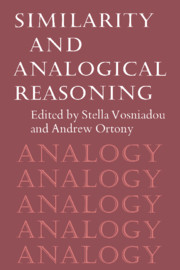Book contents
- Frontmatter
- Contents
- Preface
- List of contributors
- Similarity and analogical reasoning: a synthesis
- Part I Similarity and the structure of concepts
- Part II Analogical reasoning
- 7 The mechanisms of analogical learning
- 8 A computational model of analogical problem solving
- 9 Use of analogy in a production system architecture
- 10 Toward a microstructural account of human reasoning
- 11 Analogy and the exercise of creativity
- 12 Comments on Part II: Levels of description in information-processing theories of analogy
- 13 Comments on Part II: The role of explanation in analogy; or, The curse of an alluring name
- Part III Similarity and analogy in development, learning, and instruction
- Afterword: Comments on Parts I, II, and III: A framework for a theory of comparison and mapping
- Name index
- Subject index
9 - Use of analogy in a production system architecture
Published online by Cambridge University Press: 22 October 2009
- Frontmatter
- Contents
- Preface
- List of contributors
- Similarity and analogical reasoning: a synthesis
- Part I Similarity and the structure of concepts
- Part II Analogical reasoning
- 7 The mechanisms of analogical learning
- 8 A computational model of analogical problem solving
- 9 Use of analogy in a production system architecture
- 10 Toward a microstructural account of human reasoning
- 11 Analogy and the exercise of creativity
- 12 Comments on Part II: Levels of description in information-processing theories of analogy
- 13 Comments on Part II: The role of explanation in analogy; or, The curse of an alluring name
- Part III Similarity and analogy in development, learning, and instruction
- Afterword: Comments on Parts I, II, and III: A framework for a theory of comparison and mapping
- Name index
- Subject index
Summary
Introduction
This is a report on our development of analogy within a production system architecture. A couple of years ago we became persuaded that analogical problem solving was fundamental in the skill acquisition domains we were studying: programming and mathematical problem solving. Students were always resorting to examples from their textbooks or to examples from more familiar domains for solving these problems. We did a number of simulations of this problem solving within the ACT* architecture (Anderson, Farrell, & Sauers, 1984; Anderson, Pirolli, & Farrell, 1988; Pirolli & Anderson, 1985). However, the process of simulating this was awkward within that architecture. It was also ad hoc in the sense that the architecture offered no explanation as to why students were using analogy as their primary problem-solving method. This led us down the path of thinking about how analogy takes place and how it fits into a production system architecture. This is the first report of the new system that we have developed in response to these ruminations.
The term analogy is used in multiple senses. We are concerned with how analogy is involved in problem solving and in skill acquisition. That is, how do people call up an analogous experience to help them solve new problems? This experience can come from their own past (when analogy is sometimes called repetition), it might come from looking at the behavior of another (in which case it is sometimes called imitation), or it might come from adapting an example given in a textbook or some other expository medium (in which case it is sometimes called copying).
- Type
- Chapter
- Information
- Similarity and Analogical Reasoning , pp. 267 - 297Publisher: Cambridge University PressPrint publication year: 1989
- 34
- Cited by



